A platform that we do not cover all the time is the Supermicro SuperBlade platform. They are so big that we only get to review them every so often. The last time we did was in the Xeon E5 V3/ V4 era where we reviewed a 7U Supermicro SuperBlade. Since then, Supermicro has innovated on form factors creating blade solutions at different sizes and for different markets. Recently, we were able to get some hands-on time with a trio of Supermicro SuperBlade servers in the 4U, 6U, and 8U form factors.
Video Version
This is part of our visit to the Supermicro HQ post-lockdown series. We previously looked at the Supermicro 3rd Gen Xeon Scalable Server which we showcased alongside the Cooper Lake launch. We also looked at the Simply Double, 1U EDSFF, and the company’s new 60-Bay Top Loading Storage Server. We looked at 5G/ edge solutions such as the pole-mounted IP65 Rated Outdoor Edge System and SYS-1019P-FHN2T with Intel PAC N3000. We even checked out the new Ultra 12x NVMe 1U server. As a part of that series, we have an accompanying video:
We are going to have more detail in this article, but want to provide the option to listen. As a quick note, Supermicro filmed the video bits at their HQ, provided the systems in their demo room, and their product managers that were able to make it. We did a whole series but are tagging this as sponsored since we relied upon their facilities instead of our own. I was able to pick the products we would look at and have editorial control of the pieces (nobody is reviewing these pieces outside of STH before they go live either.) In full transparency, this was the only way to get something like this done, including looking at a number of products in one shot, without going to a trade show during shelter-in-place.
A Trio of Supermicro SuperBlade Systems
We were a bit surprised that Supermicro actually had three different SuperBlade form factors. This is a different strategy when we compare it with some of its competitors. Many of the pure white box companies do not make blade servers because they require a higher level of chassis and networking integration. Having the SuperBlade in its portfolio, and now generations of SuperBlade is a sign that SuperMicro is competing with the traditional enterprise OEMs not just in the low-cost server market. Some large OEMs have blade systems, but they like to standardize on a primary blade platform then customize that platform for different purposes. Effectively, these chassis are “good enough” for any application, but they are not necessarily as tailored. When we mean tailored, Supermicro has 4U, 6U, and 8U offerings that are not just a simple “pick your size” set. Instead, they offer distinct optimizations with their own ecosystems supporting specific applications.
Supermicro 4U SuperBlade
This was a product that prior to heading over to Supermicro I did not know about. The Supermicro 4U SuperBlade platform is designed for density. There are 14x slots for different nodes in this 4U form factor. As a result, you can get a total of 14 dual-socket nodes or 28 processors in 2U. Compare this to 2U 4-node systems and two 2U4N systems fit only 8 nodes and 16 CPUs in 4U. One gets 75% more compute density and adds networking in that footprint as well.
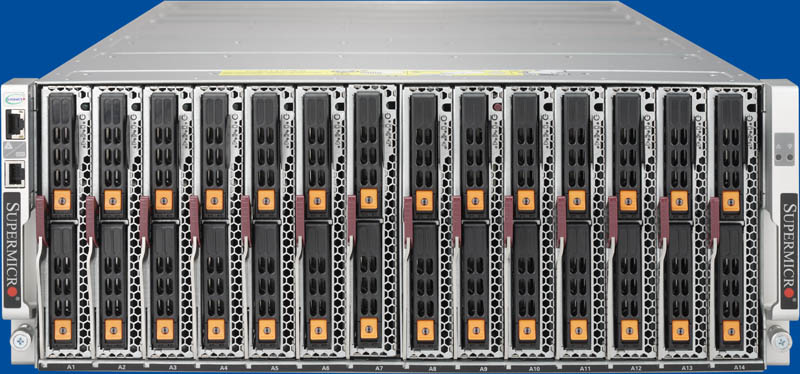
Where this makes an immediate impression is on cabling. Instead of having to individually wire BMC ports, networking, and power for 14 nodes plus 2-3 switches (two data plus one BMC/ OOB), one can use fewer cables. Taking power cables, for example, instead of needing two power inputs per node and data switch (16 devices x 2 power cables each) for 32 cables and PDU outlets, one can use only four power cables and power the entire system. In theory, you can get similar cable consolidation on the networking side as well. From an operational impact, not having to deal with cables when servicing nodes is great. We noticed the difference immediately when we did the SuperBlade reviews.
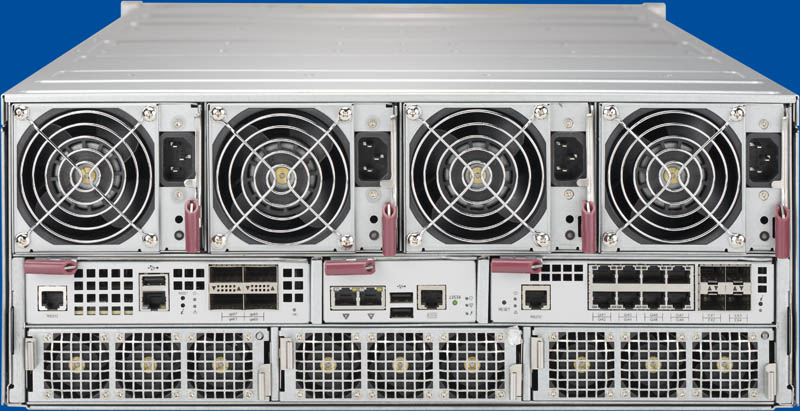
The nodes themselves are generally more focused on providing dense compute rather than maximum memory and I/O footprints. That is largely due to the dimensions needed to pack these systems so densely into a 4U rack space.

At first, we thought this is a newer version of the Supermicro MicroBlade. When we saw it in person, it was clear that this is actually a distinct product line designed for higher-power applications.
Supermicro 6U SuperBlade
The next solution we looked at was the 6U SuperBlade platform. Although it offers the same number of nodes in a 6U chassis, the additional 2U of rack height means we get different capabilities.
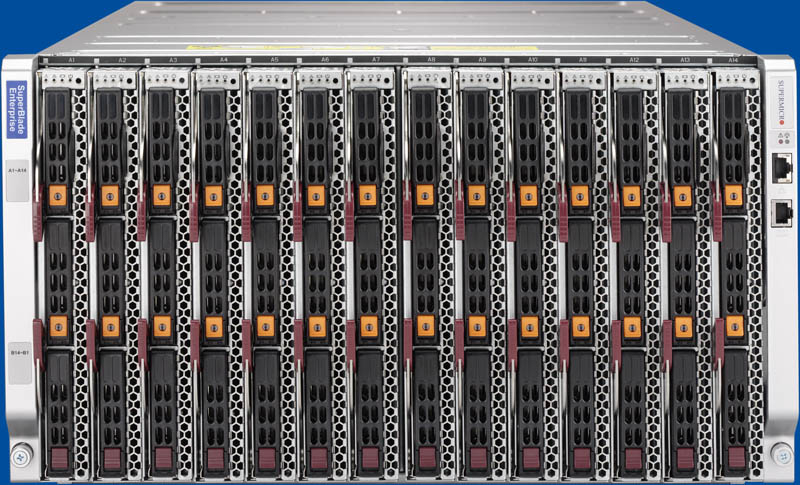
Turning to the rear of the unit, we can see one of the key features: greater power, cooling, and networking capabilities. There are eight power supplies on the 6U platform instead of four on the 4U. One also gets twice as many management and networking bays. In many ways, this is more similar to the feature set we saw on the 7U SuperBlade system we reviewed previously, just brought down to a more compact 6U form factor.
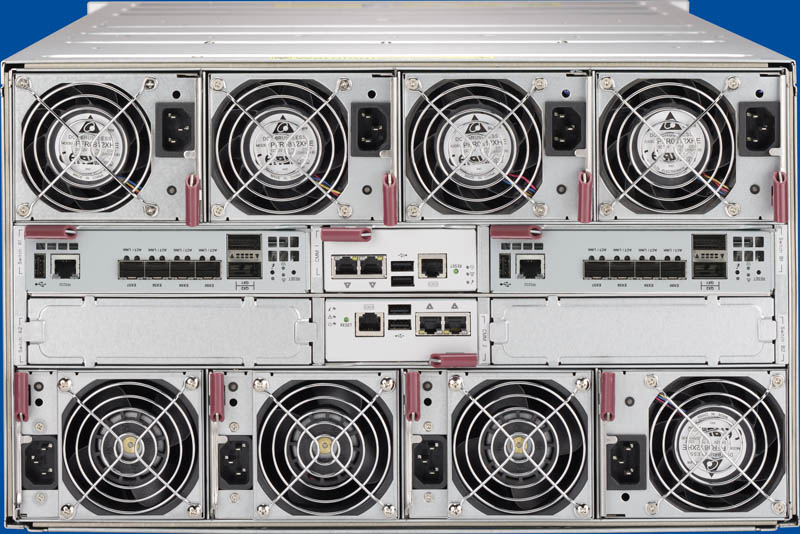
All of the extra space, power, and cooling is for an important purpose. The 6U SuperBlade platform can cool dual CPUs, but also higher-power single-socket solutions such as Xeon W. During our visit to Supermicro, Raphael Wong, Sr. Director in charge of the SuperBlade line told us that these are popular for applications with very high per-core performance needs and/ or license costs. One gets the manageability of a blade but the per-core performance of lines like the Xeon W series (e.g. the Intel Xeon W-3275 we reviewed.)
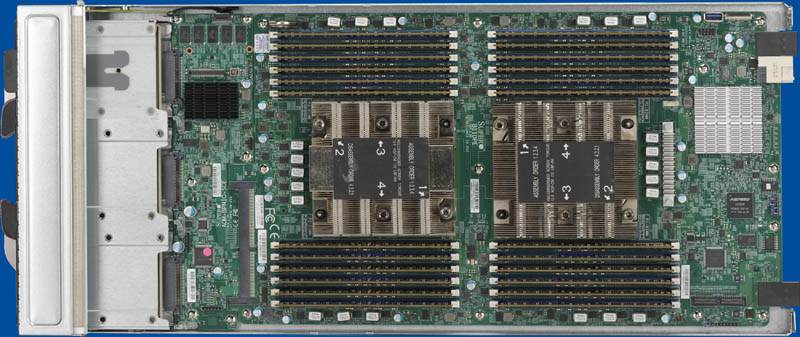
Designing for high TDP CPUs is going to be more important. As we get to future generations of processors, hitting higher frequencies will also mean increasing TDP’s. The extra room in this system also allows for full memory capacity and more storage options. One small feature that many may overlook is that these have another level of modularity. For example, one can see the storage controller/ backplane PCB is a different PCB than the man motherboard. In theory, this is designed so the motherboard can be replaced with future generations even if the storage remains intact. A key theme here is the reusability, so we are seeing vendors like Supermicro start to design that modularity into their servers.
Supermicro 8U SuperBlade
The big blade server is the 8U SuperBlade. Since this server can have two rows of nodes, one may think that it is simply two of the 4U SuperBlade, but that is not the case. The 8U SuperBlade supports up to 20 nodes with ten slots across and two high. The 4U and 6U SuperBlade platforms have 14 slots across. By using thicker nodes, the 8U SuperBlade is designed to support configurations such as GPUs and taller memory modules that would not fit on the more slender nodes of the 4U and 6U platforms.
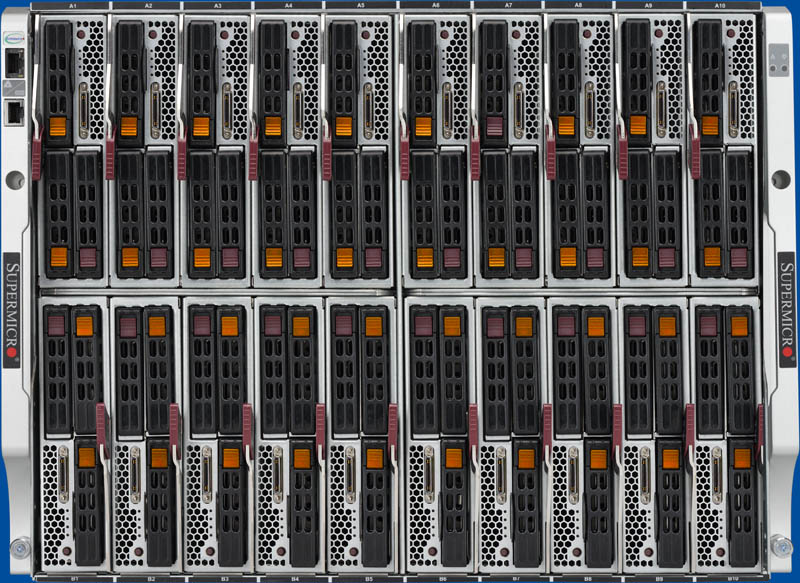
The rear of the unit is fairly similar to the 6U in terms of having up to four networking and two management bays along with eight power supplies. The clear differentiator is an additional 2U of fans for increased cooling in the platform. This system is designed for high-speed compute such as with GPUs and accelerators along with higher-end CPUs. Networking is accordingly offered up to 100Gbps Infiniband and even Intel Omni-Path.
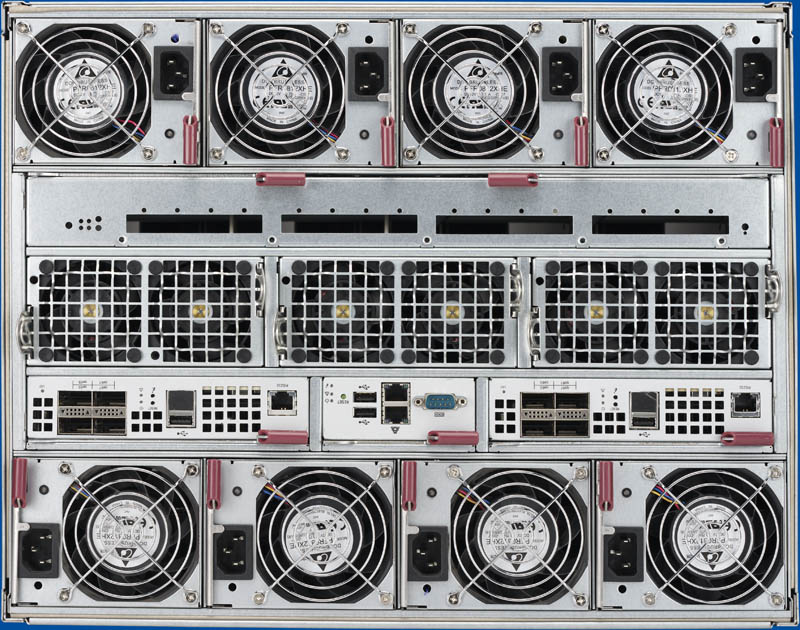
In terms of nodes, there is a fairly wide variety. We were debating whether to show the GPU node here, but instead, we are going to show the 4-socket Intel Xeon Scalable node. As you can see, one gets four sockets, full memory capacity, front NVMe storage, and even rear NVMe storage (via M.2) in this platform.
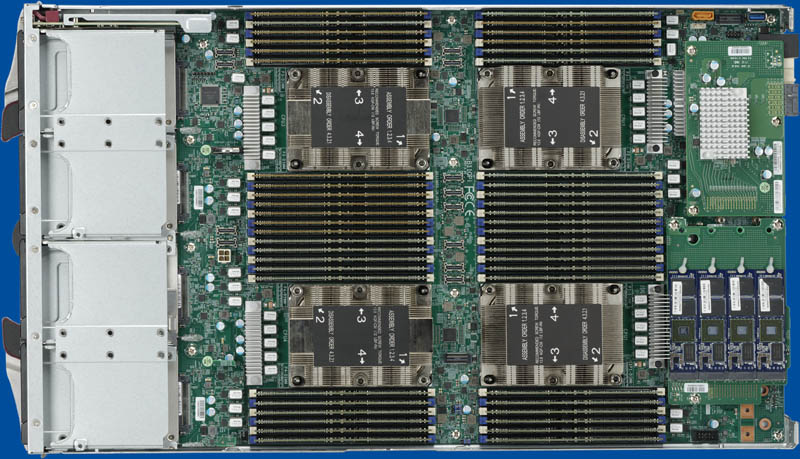
We think of this as still offering density for dual-socket nodes, but also being able to scale up to the larger nodes with more processors and accelerators versus the smaller SuperBlade form factors. That makes sense since it has a larger footprint.
Thinking Bigger
Beyond just the servers themselves, the thrust of these systems is much more important. Generally, the sheet metal, fans, and power supplies are so reliable these days that they can last through multiple generations of server hardware. By re-using the chassis components, there is less to manufacture and ship which in turn lowers the environmental impact of refreshing servers.
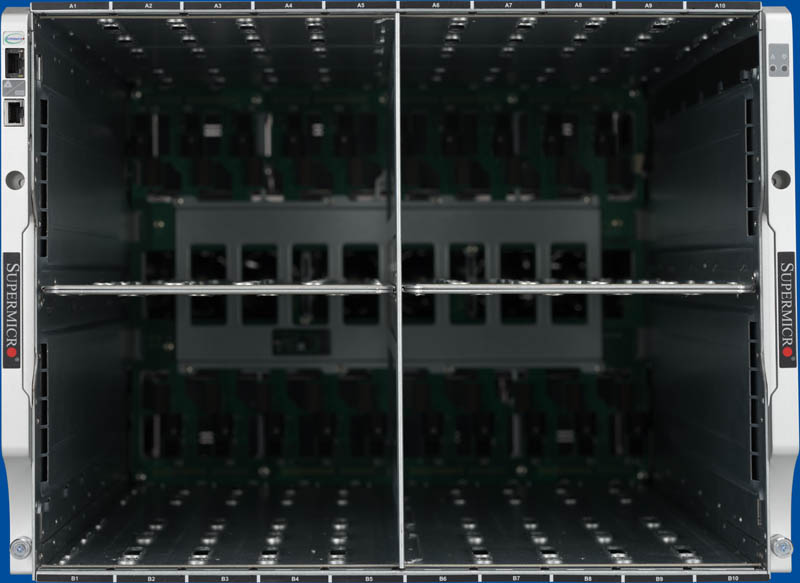
While blade servers offer a lot in terms of operational benefits, ranging from reduced cabling to easier service, as an industry, we need to look to ways to minimize environmental impact. The steel chassis should work for multiple generations.
Final Words
Supermicro has a pretty large line of blade servers and a much larger line than we thought when we first arrived. Again, we did not touch on the MicroBlade line nor any of the multi-node unit lines that come without switching and networking built-in. If you want to get into modular servers, Supermicro has a robust portfolio that is tailored to a lot of specific use cases. This trio of SuperBlade servers shows just how far the company is going in making tailored solutions for those who are looking for the serviceability, density, and flexibility of blade solutions.

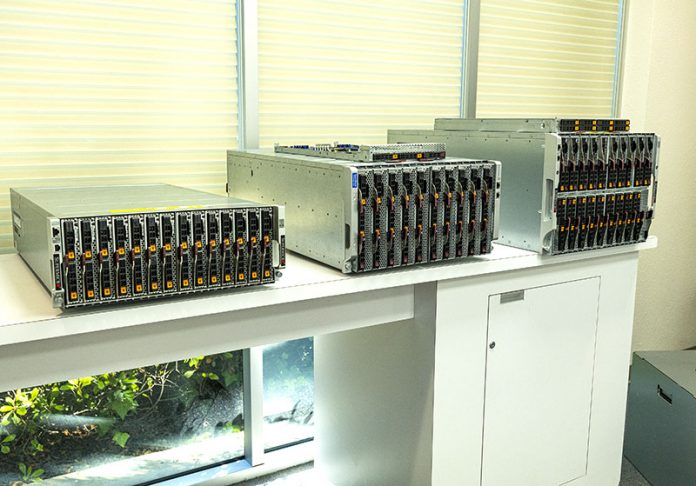



Whilst its true that the Chassis/PSU/fans can outlast the blades, so upgrading the blades can be seen as an environmentally friendly approach, one must consider what happens to the ‘obsolete’ blades.
Which in many cases are not obsolete, just no longer the latest thing. Most servers move on to have a 2nd, if not third, life in a less demanding role.
But if you leave the chassis behind, then the blade is indeed obsolete – its useless without a chassis, and the toxic waste is in the blade, not in the chassis.
So I would argue, for the bigger picture, it is more environmentally friendly to move the chassis on with the blades – up to the point that the blades are truly obsolete to anyone.
These Supermicro chassis remind me of the HP 7000 series chassis.
I bet the configuration manuals will be equally large and similarly challenging to comprehend with all of the possible options.
In other words, they trade 1 form of complexity (masses of cables and what-not) for another form of complexity (flexibility in configuring the chassis).
We tryed to go the blade server route a few years ago but there are many issues in terms of complexity as Sleepy mentionned but also in terms of logistics.
These chassis tends to be very power hungry.
The power efficiency when not fully loaded is never really good.
When you have to physically move them it is a nightmare as they are quite heavy.
They also make an unbearable noise. Qhen you have to work in the datacenter in a room where you have one of these beasts, you really wish you could pull the plug on it.
(even with earplugs)
We find the 4 nodes in 2U approach more easy to work with, even if there is the cabling issue, it also allow you to have one node with 10G, one node with 40G, one node with 1G without investing in expensive modules that are server wide.
Back on the noise and power hungryness, they are so power consuming that you need 32 amps racks if you want to put more than 2 fully loaded chassis into one footprint and here in Europe, a 32 amps rack is twice the cost of a 16A so there is no real gain in increasing the the density.
Blades are for certainly ideal for some niche market but not for us (web hosting /cloud service provider). We see many customers trying them for various uses (VDI, H/A setups) and moving back to standart 1U servers over time.